马凯军201771010116《面向对象与程序设计Java》第十三周学习总结
实验十三 图形界面事件处理技术
实验时间 2018-11-22
理论知识与学习部分
事件处理基础 事件源(event source):能够产生事件的对象都可 以成为事件源,如文本框、按钮等。一个事件源是一个 能够注册监听器并向监听器发送事件对象的对象。
事件监听器(event listener):事件监听器对象接 收事件源发送的通告(事件对象),并对发生的事件作 出响应。一个监听器对象就是一个实现了专门监听器接 口的类实例,该类必须实现接口中的方法,这些方法当 事件发生时,被自动执行。
事件对象(event object):Java将事件的相关信息 封装在一个事件对象中,所有的事件对象都最终派生于 java.util.EventObject类。不同的事件源可以产生不 同类别的事件
AWT事件处理机制的概要: 监听器对象:是一个实现了特定监听器接口( listener interface)的类实例。
事件源:是一个能够注册监听器对象并发送事件对 象的对象。
当事件发生时,事件源将事件对象自动传递给所 有注册的监听器。
监听器对象利用事件对象中的信息决定如何对事 件做出响应。
GUI设计中,程序员需要对组件的某种事件进行响应和处理时,必须完成两个步骤:
1) 定义实现某事件监听器接口的事件监听器类,并具体化接口中声明的事件处理抽象方法。
2) 为组件注册实现了规定接口的事件监听器对象;
注册监听器方法 eventSourceObject.addEventListener(eventListenerObject)
下面是监听器的一个示例: ActionListener listener = …;
JButton button=new JButton(“Ok”); button.addActionListener(listener);
动作事件(ActionEvent):当特定组件动作(点 击按钮)发生时,该组件生成此动作事件。
该 事 件 被 传 递 给 组 件 注 册 的 每 一 个 ActionListener 对象, 并 调 用 监 听 器 对 象 的 actionPerformed方法以接收这类事件对象。
能够触发动作事件的动作,主要包括:
(1) 点击按钮
(2) 双击一个列表中的选项;
(3) 选择菜单项;
(4) 在文本框中输入回车。
1、实验目的与要求
(1) 掌握事件处理的基本原理,理解其用途;
(2) 掌握AWT事件模型的工作机制;
(3) 掌握事件处理的基本编程模型;
(4) 了解GUI界面组件观感设置方法;
(5) 掌握WindowAdapter类、AbstractAction类的用法;
(6) 掌握GUI程序中鼠标事件处理技术。
2、实验内容和步骤
实验1: 导入第11章示例程序,测试程序并进行代码注释。
测试程序1:
l 在elipse IDE中调试运行教材443页-444页程序11-1,结合程序运行结果理解程序;
l 在事件处理相关代码处添加注释;
package button; import java.awt.*; import java.awt.event.*; import javax.swing.*; /** * 带按钮面板的框架 */ public class ButtonFrame extends JFrame { private JPanel buttonPanel;//定义JPanel属性 private static final int DEFAULT_WIDTH = 600; private static final int DEFAULT_HEIGHT = 400; public ButtonFrame() { setSize(DEFAULT_WIDTH, DEFAULT_HEIGHT);//通过setSize更改了宽度和高度的属性值 //创建按钮 生成了三个按钮对象,显示在窗口对象上的title文本 JButton yellowButton = new JButton("Yellow"); JButton blueButton = new JButton("Blue"); JButton redButton = new JButton("Red"); buttonPanel = new JPanel();//使new JPanel指向对象buttonPanel //向面板添加按钮 通过add方法添加三个按钮组件 buttonPanel.add(yellowButton); buttonPanel.add(blueButton); buttonPanel.add(redButton); // 将面板添加到帧 add(buttonPanel); // 创建按钮动作 ColorAction yellowAction = new ColorAction(Color.YELLOW); ColorAction blueAction = new ColorAction(Color.BLUE); ColorAction redAction = new ColorAction(Color.RED); //用按钮关联动作 监听器对象与组件之间的注册机制 yellowButton.addActionListener(yellowAction); blueButton.addActionListener(blueAction); redButton.addActionListener(redAction); } /** * 设置面板背景颜色的动作侦听器。 */ private class ColorAction implements ActionListener //ColorAction类后面实现了一个监听器接口类ActionListener { private Color backgroundColor; public ColorAction(Color c) { backgroundColor = c; } public void actionPerformed(ActionEvent event) { buttonPanel.setBackground(backgroundColor); } } }
package button; import java.awt.*; import javax.swing.*; /** * @version 1.34 2015-06-12 * @author Cay Horstmann */ public class ButtonTest { public static void main(String[] args) { EventQueue.invokeLater(() -> { JFrame frame = new ButtonFrame(); frame.setTitle("ButtonTest"); frame.setDefaultCloseOperation(JFrame.EXIT_ON_CLOSE);//默认情况下,该值被设置为 HIDE_ON_CLOSE。更改此属性的值将导致激发属性更改事件,其属性名称为 "defaultCloseOperation"。 frame.setVisible(true); }); } }

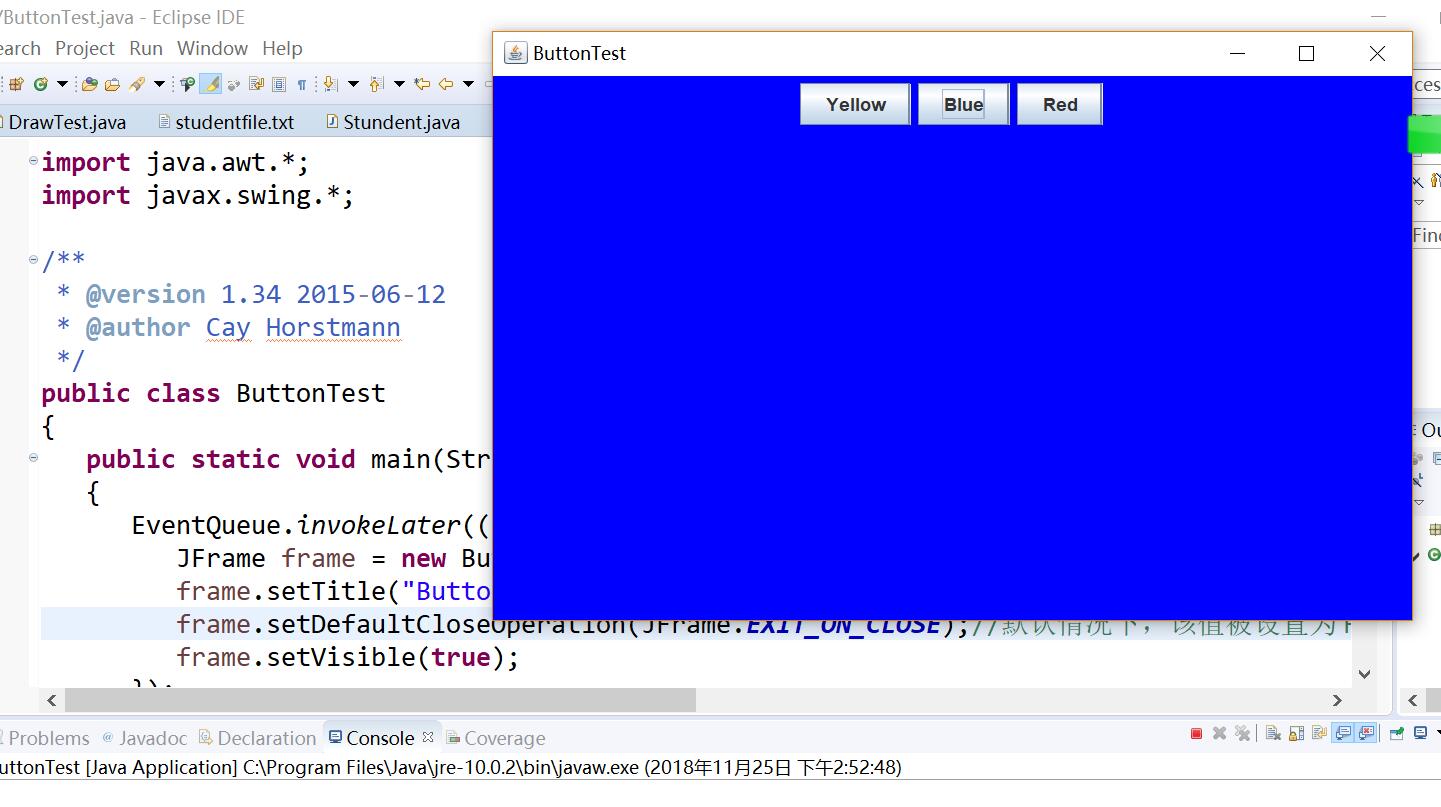

l 用lambda表达式简化程序;
l 掌握JButton组件的基本API;
l 掌握Java中事件处理的基本编程模型。
测试程序2:
l 在elipse IDE中调试运行教材449页程序11-2,结合程序运行结果理解程序;
l 在组件观感设置代码处添加注释;
l 了解GUI程序中观感的设置方法。
package plaf; import javax.swing.JButton; import javax.swing.JFrame; import javax.swing.JPanel; import javax.swing.SwingUtilities; import javax.swing.UIManager; /** * 带有按钮面板的框架,用于改变外观和感觉 */ public class PlafFrame extends JFrame { private JPanel buttonPanel; public PlafFrame() { buttonPanel = new JPanel();//实例化一个新的JPanel //获取所有的显示样式UIManager.setLookAndFeel(infos[0].getClassName()) UIManager.LookAndFeelInfo[] infos = UIManager.getInstalledLookAndFeels(); for (UIManager.LookAndFeelInfo info : infos) makeButton(info.getName(), info.getClassName()); add(buttonPanel);//增加按键点击事件 pack(); } /** * 制作一个按钮来改变可插入的外观和感觉。 * @param name the button name * @param className the name of the look-and-feel class */ private void makeButton(String name, String className) { // 向面板添加按钮 JButton button = new JButton(name); buttonPanel.add(button); // 设置按钮动作 button.addActionListener(event -> { // 按钮动作:切换到新的外观和感觉 try { //设置成你所使用的平台的外观。 java的图形界面外观有3种,默认是java的金属外观,还有就是windows系统,motif系统外观. UIManager.setLookAndFeel(className); //简单的外观更改:将树结构中的每个节点转到 updateUI() 也就是说,通过当前外观初始化其 UI 属性。 SwingUtilities.updateComponentTreeUI(this); pack();//依据放置的组件设定窗口的大小, 使之正好能容纳放置的所有组件 } catch (Exception e)//抛出异常 { e.printStackTrace();//深层次的输出异常调用的流程。 } }); } }
package plaf; import java.awt.*; import javax.swing.*; /** * @version 1.32 2015-06-12 * @author Cay Horstmann */ public class PlafTest { public static void main(String[] args) { EventQueue.invokeLater(() -> { JFrame frame = new PlafFrame();//生成PlafFrame对象 frame.setTitle("PlafTest");//设置组建的自定义标题测试按钮 frame.setDefaultCloseOperation(JFrame.EXIT_ON_CLOSE);//设置默认的关闭操作,参数在关闭动作时退出 frame.setVisible(true);//一个图形界面默认都是不可见的,setVisible把图形界面设置为可见 }); } } PlafTest





测试程序3:
l 在elipse IDE中调试运行教材457页-458页程序11-3,结合程序运行结果理解程序;
l 掌握AbstractAction类及其动作对象;
l 掌握GUI程序中按钮、键盘动作映射到动作对象的方法。
package action; import java.awt.*; import java.awt.event.*; import javax.swing.*; /** * 具有显示颜色变化动作的面板的框架 */ public class ActionFrame extends JFrame { private JPanel buttonPanel; private static final int DEFAULT_WIDTH = 500; private static final int DEFAULT_HEIGHT = 200; public ActionFrame() { setSize(DEFAULT_WIDTH, DEFAULT_HEIGHT); // 设置默认宽度和高度 buttonPanel = new JPanel(); // 将类的实例域中的JPanel面板对象实例化 Action yellowAction = new ColorAction("Yellow", new ImageIcon("yellow-ball.gif"), Color.YELLOW); // 创建一个自己定义的ColorAction对象yellowAction Action blueAction = new ColorAction("Blue", new ImageIcon("blue-ball.gif"), Color.BLUE); Action redAction = new ColorAction("Red", new ImageIcon("red-ball.gif"), Color.RED); //创建一个按钮,其属性从所提供的 Action中获取 buttonPanel.add(new JButton(yellowAction)); buttonPanel.add(new JButton(blueAction)); buttonPanel.add(new JButton(redAction)); //我们将这个添加好按钮的面板添加到原框架中 add(buttonPanel); //我们将JPanel对象的InputMap设置为第二种输入映射,并创建该对象 InputMap imap = buttonPanel.getInputMap(JComponent.WHEN_ANCESTOR_OF_FOCUSED_COMPONENT); imap.put(KeyStroke.getKeyStroke("ctrl Y"), "panel.yellow"); imap.put(KeyStroke.getKeyStroke("ctrl B"), "panel.blue"); imap.put(KeyStroke.getKeyStroke("ctrl R"), "panel.red"); // 在imap中通过调用击键类KeyStroke的静态方法设置击键输入ctrl+Y的组合 // 第二个参数是一个标志参数,将这对参数用键值对的形式存入imap // 将imap中标记参数对应的击键组合和相应的Action组合起来 ActionMap amap = buttonPanel.getActionMap(); amap.put("panel.yellow", yellowAction); amap.put("panel.blue", blueAction); amap.put("panel.red", redAction); } public class ColorAction extends AbstractAction { /** * 构造颜色动作。 * @param name the name to show on the button * @param icon the icon to display on the button * @param c the background color */ public ColorAction(String name, Icon icon, Color c) { putValue(Action.NAME, name); putValue(Action.SMALL_ICON, icon); putValue(Action.SHORT_DESCRIPTION, "Set panel color to " + name.toLowerCase()); putValue("color", c); //在构造器中设置一些键值对映射,这些设置的属性将会被JPanel读取 } /** * 当按钮点击或击键的时候,会自动的调用actionPerformed方法 */ public void actionPerformed(ActionEvent event) { Color c = (Color) getValue("color"); buttonPanel.setBackground(c); // 调用setBackground方法,设置背景颜色 } } }
package action; import java.awt.*; import javax.swing.*; /** * @version 1.34 2015-06-12 * @author Cay Horstmann */ public class ActionTest { public static void main(String[] args) { EventQueue.invokeLater(() -> { JFrame frame = new ActionFrame();//生成ActionFrame对象 frame.setTitle("ActionTest");//设置组建的自定义标题测试按钮 frame.setDefaultCloseOperation(JFrame.EXIT_ON_CLOSE);//设置默认的关闭操作,参数在关闭动作时退出 frame.setVisible(true);//一个图形界面默认都是不可见的,setVisible把图形界面设置为可见 }); } }

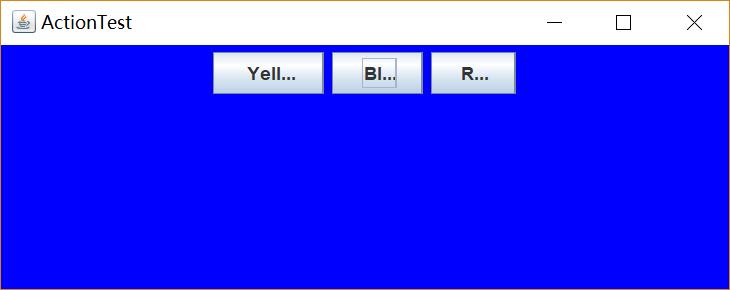
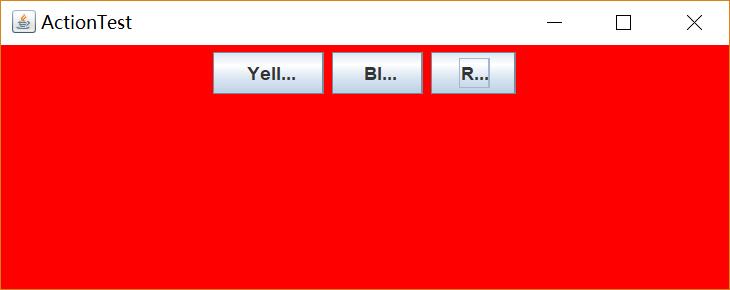
测试程序4:
l 在elipse IDE中调试运行教材462页程序11-4、11-5,结合程序运行结果理解程序;
l 掌握GUI程序中鼠标事件处理技术。
package mouse; import java.awt.*; import java.awt.event.*; import java.awt.geom.*; import java.util.*; import javax.swing.*; /** * 一个带有鼠标操作的用于添加和删除正方形的组件。 */ public class MouseComponent extends JComponent { private static final int DEFAULT_WIDTH = 300; private static final int DEFAULT_HEIGHT = 200; private static final int SIDELENGTH = 10;// 定义创造的正方形的边长 private ArrayList<Rectangle2D> squares;// 声明一个正方形集合 private Rectangle2D current; // java类库中用来描述矩形的类,它的对象可以看作是一个矩形 public MouseComponent() { squares = new ArrayList<>(); current = null; addMouseListener(new MouseHandler()); // 添加一个我们实现的类,这个类继承了监测鼠标点击情况的MouseListener addMouseMotionListener(new MouseMotionHandler()); // 添加另一个实现类,这个类继承了监测鼠标移动情况的MouseMotionListener } public Dimension getPreferredSize() { return new Dimension(DEFAULT_WIDTH, DEFAULT_HEIGHT); } public void paintComponent(Graphics g) { Graphics2D g2 = (Graphics2D) g; // 转换为我们需要使用的类型 // 绘制所有正方形 for (Rectangle2D r : squares) g2.draw(r); // 对数组中的每个正方形,都进行绘制 } /** * 判断在这个坐标上是否有图形 * @param p a point * @return the first square that contains p */ public Rectangle2D find(Point2D p) { for (Rectangle2D r : squares) { if (r.contains(p)) //contains方法测定坐标是否在图形的边界内 return r; } // 如果在squares这个数组中有这个位置的坐标,表明这个位置上非空 // 返回这个位置上的对象 return null; // 否则如果什么都没有,返回null } /** * 在这个坐标位置增加一个图形 * @param p the center of the square */ public void add(Point2D p) { double x = p.getX(); double y = p.getY(); //获取x和y的坐标 current = new Rectangle2D.Double(x - SIDELENGTH / 2, y - SIDELENGTH / 2, SIDELENGTH, SIDELENGTH); //用获得的坐标和既定的边长构建一个新的正方形,并将其赋值给current squares.add(current);//将current添加到squares队列中 repaint();//重绘图像 } /** * 从集合中移除正方形。 * @param s the square to remove */ public void remove(Rectangle2D s) { if (s == null) return;//如果要移除的内容为空,直接返回 if (s == current) current = null; //如果要移除的内容和current正指向的内容相同,则将current清空 //避免发生不必要的错误 squares.remove(s);//将s从squares的列表中直接删去 repaint();//重绘component的方法 } private class MouseHandler extends MouseAdapter { public void mousePressed(MouseEvent event)//鼠标按下方法 { // 如果光标不在正方形中,则添加一个新的正方形 current = find(event.getPoint()); // 将鼠标单击的这个点的坐标的对象赋给current if (current == null) //如果这个点没有对象,当前指向空的位置 add(event.getPoint()); //在这个点绘制正方形 } public void mouseClicked(MouseEvent event)//鼠标单击方法 { // 如果双击,删除当前方块 current = find(event.getPoint());// 将鼠标单击的这个点的坐标的对象赋给current if (current != null && event.getClickCount() >= 2) //如果这个点有对象,而且点击鼠标的次数大于2 remove(current); //移除current } } private class MouseMotionHandler implements MouseMotionListener { public void mouseMoved(MouseEvent event)//如果鼠标移动 { // set the mouse cursor to cross hairs if it is inside设置鼠标光标 //矩形; if (find(event.getPoint()) == null) //如果鼠标所在位置不是空 setCursor(Cursor.getDefaultCursor()); //则将光标的图像设置为默认的图像 else setCursor(Cursor.getPredefinedCursor(Cursor.CROSSHAIR_CURSOR)); //如果当前位置有图像,则将光标样式设置为手型 } public void mouseDragged(MouseEvent event)//如果鼠标拖动 { if (current != null)
{
//因为在调用这个方法之前肯定会调用点击鼠标的方法
//所以我们直接判断:如果现在current不为空
//像素(强制转换为int)
int x = event.getX();
int y = event.getY();
//获取到坐标
current.setFrame(x - SIDELENGTH / 2, y - SIDELENGTH / 2, SIDELENGTH, SIDELENGTH);
//最后在鼠标放下时进行图形绘制
repaint();//重绘图像
}
}
}
}
package mouse; import javax.swing.*; /** * 继承JFrame的子类,将Component对象内容打包 */ public class MouseFrame extends JFrame public MouseFrame() { add(new MouseComponent());//向框架中添加一个JComponent的实例 pack();//依据放置的组件设定窗口的大小, 使之正好能容纳放置的所有组件 } } MouseFrame
package mouse; import java.awt.*; import javax.swing.*; /** * @version 1.34 2015-06-12 * @author Cay Horstmann */ public class MouseTest { public static void main(String[] args) { EventQueue.invokeLater(() -> { JFrame frame = new MouseFrame();//生成MouseFrame对象 frame.setTitle("MouseTest");//设置组建的自定义标题测试按钮 frame.setDefaultCloseOperation(JFrame.EXIT_ON_CLOSE);//设置默认的关闭操作,参数在关闭动作时退出 frame.setVisible(true);//一个图形界面默认都是不可见的,setVisible把图形界面设置为可见 }); } } MouseTest
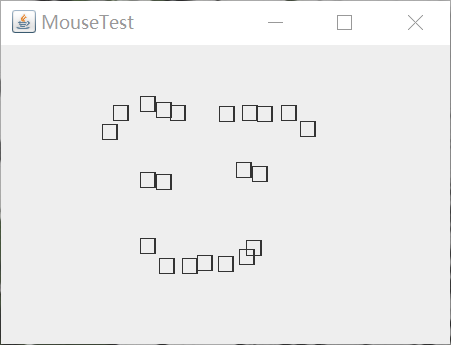
实验2:结对编程练习
利用班级名单文件、文本框和按钮组件,设计一个有如下界面(图1)的点名器,要求用户点击开始按钮后在文本输入框随机显示2017级网络与信息安全班同学姓名,如图2所示,点击停止按钮后,文本输入框不再变换同学姓名,此同学则是被点到的同学姓名。
图1 点名器启动界面
图2 点名器点名界面
package 点名器; import java.util.*; import java.awt.*; import javax.swing.*; import java.awt.event.*; import java.io.File; import java.io.FileNotFoundException; import javax.swing.event.*; public class NameFrame extends JFrame implements ActionListener{ private JLabel jla; private JLabel jlb; private JButton jba; private static boolean flag = true;//私有静态布尔标志=真 public NameFrame(){ this.setLayout(null); jba = new JButton("开始"); jla = new JLabel("姓名"); jlb = new JLabel("随机点名器"); this.add(jla); this.add(jlb); jla.setFont(new Font("Courier",Font.PLAIN,44)); jla.setHorizontalAlignment(JLabel.CENTER); jla.setVerticalAlignment(JLabel.CENTER); jla.setBounds(20,100,180,30);//这里定义的姓名的大小位置方位 jlb.setOpaque(true); jlb.setBackground(Color.cyan); jlb.setFont(new Font("Courier",Font.PLAIN,22));//设置字体 jlb.setHorizontalAlignment(JLabel.CENTER); jlb.setVerticalAlignment(JLabel.CENTER); jlb.setBounds(150,100,120,30); this.add(jba); jba.setBounds(200,150,70,23); jba.addActionListener(this); this.setTitle("点名器");//设置窗格大小 this.setBounds(500,500,400,300); this.setVisible(true); this.setDefaultCloseOperation(DISPOSE_ON_CLOSE); } public void actionPerformed(ActionEvent e){ int i=0; String names[]=new String[50]; try { Scanner in=new Scanner(new File("D:\\studentnamelist.txt"));//文件地址 while(in.hasNextLine()) { names[i]=in.nextLine(); i++; } } catch (FileNotFoundException e1) { // TODO Auto-generated catch block e1.printStackTrace(); } if(jba.getText()=="开始"){ jlb.setBackground(Color.cyan);//设置此组件的背景色 flag = true; new Thread(){ public void run(){ while(NameFrame.flag){ Random r = new Random(); int i= r.nextInt(47); jlb.setText(names[i]); } } }.start(); jba.setText("停止"); jba.setBackground(Color.GREEN);//设置停止按钮的颜色 } else if(jba.getText()=="停止"){ flag = false; jba.setText("开始"); jba.setBackground(Color.BLUE);//开始按钮的背景颜色 jlb.setBackground(Color.lightGray); } } public static void main(String arguments []){ new NameFrame(); } }
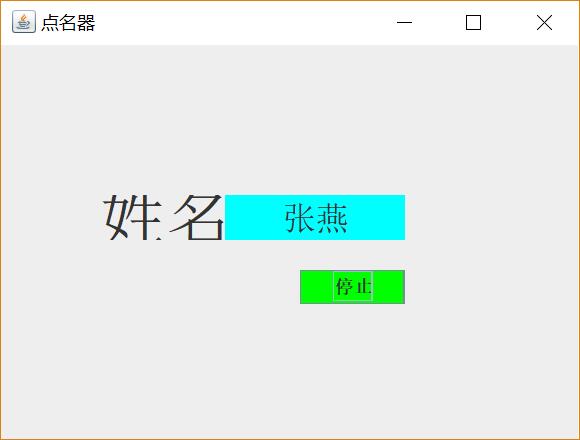

实验总结:
通过这次实验,我理解了AWT事件模型的工作机制,以及事件处理的基本编程模型,了解了GUI界面组件观感设置方法,也对WindowAdapter类的用法有了基本的了解,GUI程序中鼠标事件处理技术。虽然学长将点名程序发给了我们,但是我还是很多地方没懂,所以没有怎么修改,以后还是要多读程序,对以前学的知识也要多看,这样才能为以后打下基础。


 浙公网安备 33010602011771号
浙公网安备 33010602011771号